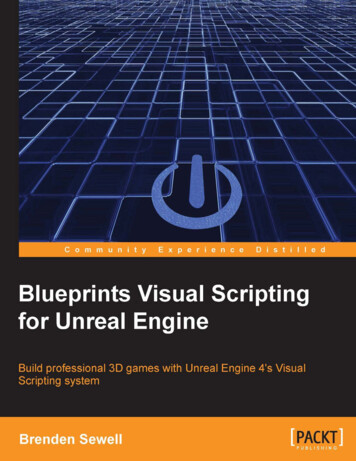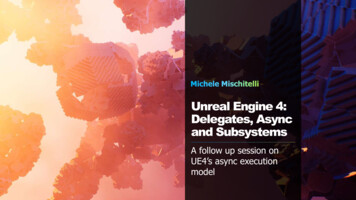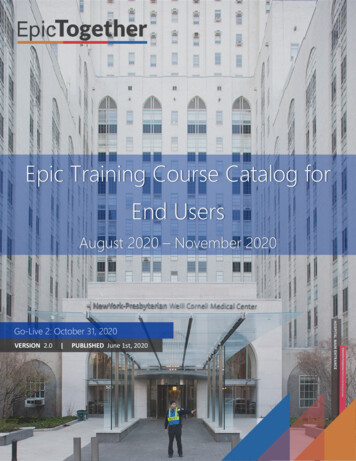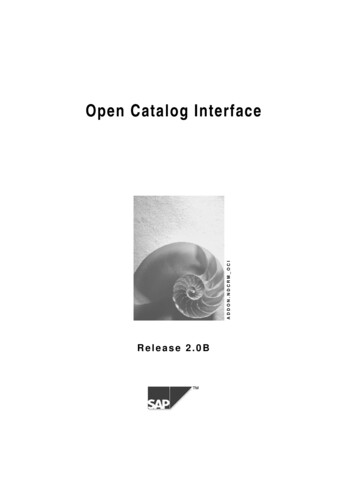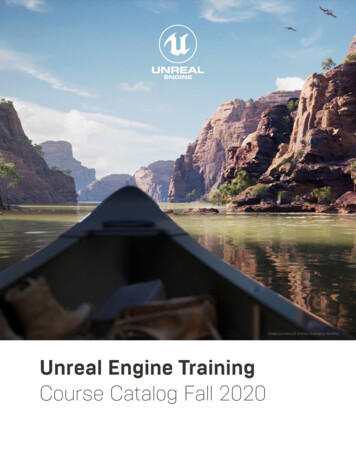
Transcription
Image courtesy of Andrew Svanberg HamiltonUnreal Engine TrainingCourse Catalog Fall 2020
Unreal Engine Training: Course Catalog Fall 2020ContentsPAGE1.Curriculum building blocks4General introduction to Unreal Engine - 3 days4Artists and designers deep dive - additional 2 days4Tech artists and developers deep dive - additional 2 days5Virtual production deep dive - additional 2 days5Animation deep dive - additional 2 days5Live Q&A62. Course descriptions6Introduction6100.1 Introduction to Unreal Engine6100.2 Quick Start: Your First Project in Unreal Engine7Materials8101.1 Materials - Introduction8201.1 Materials - Masking and Material Functions8201.2 Materials - Translucent, Displacement, and VFX9Lighting9103.1 Lighting - Introduction9203.2 Lighting - Cinematic Fundamentals10203.3 Lighting - Ray Tracing, Atmospheric Lighting, and Optimization11209.1 Post Processing and Rendering for Virtual Production11Static Mesh Ingestion12206.1 Static Mesh Ingestion with FBX12206.2 Static Mesh Ingestion for AEC12206.3 Static Mesh Ingestion for CAD13206.4 Automation and Visual Dataprep13Optimization14204.1 Optimization Introduction14204.2 Optimization Challenge142
Unreal Engine Training: Course Catalog Fall 2020Contents continuedPAGESequencer15105.1 Quick Start - Sequencer for Virtual Production15105.2 Sequencer - Introduction16205.1 Sequencer - Production Workflow and CineCamera Techniques16205.2 Sequencer - Performance Capture with Take Recorder17205.3 Sequencer - VCam Shot Creation and Editing17Blueprints18102.1 Introduction to Blueprint18102. 3 Quickstart - Blueprint for Virtual Production19102.2 Introduction to Creating User Interfaces with UMG and Blueprints19202.1 Blueprint Set Up for Scalability: Interface System and Parent/Child Classes20202.2 Blueprint Project - Your First Mobile App with Blueprint and UMG20202.3 Blueprint - Introduction to Creating Custom Tools21Animation22107.1 Animation - Importing and Subeditors22107.2 Animation - Retargeting and Reusing Animations23107.3 Animation - Introduction to Runtime Animation for Games23207.1 Animation - Advanced Importing & Livelink23207.2 Animation - Blending Controls24207.3 Animation - Control Rig243
Unreal Engine Training: Course Catalog Fall 2020Image courtesy of Valentin Bécart Odilon Loïez Digital art by Studio A N FCurriculum building blocksCombine the following learning paths to build a curriculum that meets your needs.General introduction to Unreal Engine - 3 days 100.1 Introduction to Unreal Engine (self-paced learning video)1.100.2 Quick Start: Your First Project in Unreal Engine2. 101.1 Materials - Introduction3. 103.1 Lighting - Introduction4. 102.1 Blueprint - Introduction5. 102.2 Blueprint - Introduction to UMG and Creating Simple User Interfaces6. 105.2 Sequencer - Introduction7.206.2 Static Mesh Ingestion for AEC8. 206.1 Static Mesh Ingestion with FBX9. 204.1 Optimization - IntroductionArtists and designers deep dive - additional 2 days1.201.1 Materials - Masking and Material Functions2. 201.2 Materials - Translucent, Displacement, and VFX3. 203.2 Lighting - Cinematic Fundamentals4. 203.3 Lighting - Ray Tracing, Atmospheric Lighting, and Optimization5. 209.1 Post Processing and Rendering for Virtual Production6. 204.2 Optimization Challenge4
Unreal Engine Training: Course Catalog Fall 2020Image courtesy of ZOANTech artists and developers deep dive - additional 2 days202.1 Blueprint - Set up for Scalability: Interface System and Parent/Child Classes202.2 Blueprint Project - Your First Mobile Application with Blueprint and UMG202.3 Blueprint - Introduction to Creating Custom Tools with Blueprint Construction Scripts206.2 Static Mesh Ingestion for AEC206.4 Automation and Visual Dataprep204.2 Optimization ChallengeVirtual production deep dive - additional 2 days1.102. 3 Quickstart - Blueprint for Virtual Production2. 105.1 Quick Start - Sequencer for Virtual Production3. 205.1 Sequencer - Production Workflow and CineCamera Techniques4. 205.3 Sequencer - VCam Shot Creation and Editing5. 205.2 Sequencer - Performance Capture with Take Recorder6. Live Q & AAnimation deep dive - additional 2 days1.107.1 Animation - Importing and Subeditors2. 107.2 Animation - Retargeting and Reusing Animations3. 207.1 Animation - Advanced Importing & Live Link4. 207.2 Animation - Blending Controls5. 207.3 Animation - Control Rig6. Live Q&A5
Unreal Engine Training: Course Catalog Fall 2020Image courtesy of Andrew Svanberg HamiltonCourse descriptionsIntroduction100.1 Introduction to Unreal EngineThis course provides an overview to the engine as well as examples of how businesses are creating stunning real-timevisuals for film, television, theater, architecture, design, and manufacturing.The presentation also provides a high-level understanding of game engine principles along with an overview of theUnreal Editor and its various tools.By the end of this class, participants will be able to: Explain what the Epic Games launcher is used forUtilize the online learning resourcesUtilize sample projects and other resources, including free and paid contentUnderstand and work with Unreal Engine’s project structureExplain how to bring in data such as geometry, lights, cameras, animation, and moreNavigate in a sceneFind their way around the Unreal Engine Editor and utilize some of the most common toolsExplain the concepts of Physically Based Rendering (PBR) and how they affect Materials in Unreal EngineDifferentiate dynamic versus static lightingExplain the basics of the Blueprint visual scripting systemPrerequisites:Download and install Unreal Engine6
Unreal Engine Training: Course Catalog Fall 2020Image courtesy of Quixel100.2 Quick Start: Your First Project in Unreal EngineIn this beginner class, you will create a simple project that showcases a typical workflow in Unreal Engine.At the end of this class, participants will be able to: Start a project using a base templateGet content from the Marketplace and load starter contentImport data using Datasmith and FBXPlace, transform, and duplicate assets to create an environmentLight an exterior scene using different light types and mobility settingsCreate and apply simple MaterialsCreate a basic terrain and sculpt with terrain editing toolsAdd foliage with the Foliage Paint and editing toolsPrerequisites:100.1 Introduction to Unreal Engine7
Unreal Engine Training: Course Catalog Fall 2020Materials101.1 Materials - IntroductionIn this class, you will learn introductory material techniques in Unreal Engine.At the end of this class, participants will be able to: Create Material Masters and Material InstancesAnimate Materials using the Panner node and layeringCreate Materials using Materials parameters for alpha channelsControl Material domains, Blend modes, and Shading ModelsPrerequisites:100.1 Introduction to Unreal Engine201.1 Materials - Masking and Material FunctionsIn this class, you will learn intermediate material techniques in Unreal Engine.At the end of this class, participants will be able to: Make an Instance Material to control UVsSwitch between a color or texture as well as values of Material propertiesUse a Material function to make an Emissive Material and attach it to a lightCreate a single Material that uses masking techniquesPrerequisites:101.1 Materials - Introduction8
Unreal Engine Training: Course Catalog Fall 2020201.2 Materials - Translucent, Displacement, and VFXIn this class, you will learn advanced material techniques in Unreal Engine.At the end of this class, participants will be able to: Create plant Materials using Shading Models and subsurface optionsCreate a dissolve effect using Material functionsCreate a translucent Material and add secondary effects such as Bump OffsetCreate displacement Materials using the Material settingsPrerequisites:101.1 Materials - Introduction201.1 Materials - Masking and Material FunctionsLighting103.1 Lighting - IntroductionIn this class, you will learn the basics of Unreal Engine lighting.At the end of this class, participants will be able to: Apply different light types and properties in different scenariosExplain the three states of light mobilityDifferentiate between static and dynamic lightingUse Lightmass efficiently to bake lighting and shading info onto geometryUtilize Lightmaps for optimal performanceLeverage Lightmass Importance Volume and Post-Process VolumeUnderstand and use the different reflection types offered in Unreal EnginePrerequisites:100.1 Introduction to Unreal Engine9
Unreal Engine Training: Course Catalog Fall 2020203.2 Lighting - Cinematic FundamentalsIn this class, you will learn the basics of cinematic lighting in Unreal Engine.After completing this course, you will be able to: Create realistic lighting for environmentsControl exposure with Viewmode Exposure and Post-Process EffectsControl outdoor and interior lightingUse Screen Space Global IlluminationLight a characterPrerequisites:100.1 Introduction to Unreal Engine10
Unreal Engine Training: Course Catalog Fall 2020203.3 Lighting - Ray Tracing, Atmospheric Lighting, and OptimizationIn this class, you will learn additional intermediate lighting techniques.At the end of this class, you will be able to: Create a scene that uses ray-traced lighting ActorsCreate Materials and attach them to Post-Process Effects for stylized visual looksAdd atmospheric lighting to fog to create an effectCreate Blueprints for ray-tracing optimizationPrerequisites:100.1 Introduction to Unreal Engine209.1 Post Processing and Rendering for Virtual ProductionIn this class, you will learn post production and final render techniques within Unreal Engine.At the end of this class, you will be able to: Use LUT for color gradingUse Post-Process Volumes to control the color of a sceneExplain post-process exposure control in the viewportRender image sequences using the Movie Render QueueExplain how to create custom render passesExport data from Unreal Engine for use in offline editingPrerequisites:203.2 Lighting - Cinematic Fundamentals203.3 Lighting - Ray Tracing, Atmospheric Lighting, and Optimization205.2 Sequencer - Production Workflow and CineCamera Techniques11
Unreal Engine Training: Course Catalog Fall 2020Static Mesh Ingestion206.1 Static Mesh Ingestion with FBXIn this class, you will learn the basics of Static Mesh import with FBX. This interop format is the most common way ofimporting models into Unreal Engine and works well when sorting assets one at a time.At the end of this class, participants will be able to: Import Static Meshes and discover the options of the FBX Import dialog boxUtilize Unreal Engine’s Mesh Editing tools to make minor adjustments inside of the engineOrganize Texture and Lightmap UVs in both DCC apps and inside of Unreal EngineGenerate Collision objects in both your DCC app and inside of UnrealGenerate LODsImport Skeletal MeshesUtilize the FBX Full Scene Import option to import fully assembled scenesPrerequisites:100.1 Introduction to Unreal Engine206.2 Static Mesh Ingestion for AECIn this class, you will learn the basics of Static Mesh import for architectural models created in digital content creation(DCC) applications such as Autodesk 3ds Max, Autodesk Revit, or Trimble Sketchup Pro.At the end of this class, participants will be able to: Recognize the impact the Datasmith file format and workflow has on project developmentAssess how Datasmith works and how it parses informationDownload and install Datasmith exporters for specific DCC applicationsRecognize how Datasmith handles hierarchies and pivot points for imported objectsUtilize the Mesh Editing tools to make adjustments to geometry from within Unreal EngineGenerate Collisions for a mesh using the Static Mesh EditorGenerate LODs for a mesh using the Static Mesh EditorRecognize the significance of merging Actors in a scene to improve performancePrerequisites:100.1 Introduction to Unreal Engine12
Unreal Engine Training: Course Catalog Fall 2020206.3 Static Mesh Ingestion for CADIn this class, you will learn the basics of Static Mesh import for CAD data created in applications such as Solidworks,Catia, Rhino, Inventor, and many others.At the end of this class, participants will be able to: Recognize the impact the Datasmith file format and workflow has on project developmentDeconstruct tessellation of CAD geometry to determine how coarse or fine it appears inside of Unreal EngineUtilize Mesh Editing tools to make adjustments to your geometry directly inside of Unreal EngineGenerate LODs for a mesh in Unreal Engine using the Static Mesh EditorImprove performance by merging Actors and generating ProxiesPrerequisites:100.1 Introduction to Unreal Engine206.4 Automation and Visual DataprepIn this class, you will learn how to work with Unreal Engine’s Visual Dataprep tools to sift through a Datasmith file andmake changes and adjustments before you commit to importing it into Unreal Engine.At the end of this class, participants will be able to: Assess the importance of automating the Datasmith import processDiscover Python scripting automation to load a Datasmith fileUtilize Python scripting to generate LODs and replace materials quickly and efficientlyDiscover Visual DataprepAssess the Visual Dataprep workflow and recognize how it can help the process of Datasmith ingestionDevelop “recipes” to automate cleanup and scene management before you commit the changes to the Unreal EditorPrerequisites:206.2 Static Mesh Ingestion for AECor206.3 Static Mesh Ingestion for CAD13
Unreal Engine Training: Course Catalog Fall 2020Optimization204.1 Optimization IntroductionThis class introduces optimization concepts and profiling tools and techniques.At the end of this class, you will be able to: Understand fundamental optimization conceptsUtilize the optimization view modes to identify performance issues in your scenesBe able to use the Audit Asset tools to determine which assets are taking up the most memory/disk spaceUnderstand when to use the built-in optimization tools and why one tool should be used over anotherOptimize Meshes, Textures, Materials and lighting using built-in toolsUnderstand ways to increase ray tracing scene performancePrerequisites:100.1 Introduction to Unreal Engine204.2 Optimization ChallengeIn this hands-on workshop, we introduce you to a variety of profiling and optimization tools available within UnrealEngine, and you'll explore commonly used techniques such as mesh instancing, LODs, HLODs, culling methods, mergeActors, lighting modes, and viewport visualizations to increase performance. You will begin with a performance-heavyscene, and together we will optimize it. By the end of the session, you will have the sample scene running smoothly andthe skills required to analyze, profile, and optimize any scene in your own projects.At the end of this class, you will be able to: Quickly identify issues that could be contributing to performance problems Balance your project’s visual needs and performance goals Understand how to use the GPU profiling tools to locate performance issues in a scenePrerequisites:204.1 Optimization - Introduction14
Unreal Engine Training: Course Catalog Fall 2020Sequencer105.1 Quick Start - Sequencer for Virtual ProductionIn this class, you will learn how to set up your first virtual production project and explore hands-on virtual camera(vCam) controls. If you’ll be working with Unreal Engine in virtual production, this is the introductory class for you.At the end of this class, you’ll be able to: Install virtual production pluginsUnderstand sequence managementAnimate CineCameras using SequencerCreate a simple shot sequence in SequencerSet up vCam using Unreal Remote 2 app for camera recordingSet up Live Link Face App for facial capturePrerequisites:100.1 Introduction to Unreal EngineAdditional ne/Plugins/VirtualCameraPlugin/index.html15
Unreal Engine Training: Course Catalog Fall 2020105.2 Sequencer - IntroductionIn this class, you will learn the basics for working with Unreal Engine’s cinematic creation tool, Sequencer.At the end of this class, participants will be able to: Understand the different functions of a sequence in Unreal Engine, including the hierarchical difference betweenshot sequences, a sub level track, and a take Build their first cinematic sequence with keyframed cameras, animations, and cuts Generate rendered movies from Sequencer using the Render Movie settingPrerequisites:100.1 Introduction to Unreal Engine205.1 Sequencer - Production Workflow and CineCamera TechniquesIn this class, you will discover additional features in Sequencer, explore organization structures, and utilize Sequencer’sediting capabilities through the application of new CineCamera tools and Modification tracks.At the end of this class, participants will be able to: Explain the use of subscenes to organize tracks for visual effects, audio, and animation, and to trigger eventsbetween tracks or communicate between tracks Blend shots in the camera cuts track using the Curve Editor as well as use Look At and Focus tracking to follow asubject within those shots Utilize the Curve Editor for key manipulation Utilize cinematic camera tools, rig rail, and crane to animate the camera Apply various tools such as visibility, transform, time dilation, and fade tracks to refine the animationPrerequisites:105.2 Sequencer - Introduction16
Unreal Engine Training: Course Catalog Fall 2020205.2 Sequencer - Performance Capture with Take RecorderIn this class, you will cover setting up recordable Actors and CineCameras, placing them in a virtual set, and recordingphysical and facial performances through Take Recorder.By the end of this class, you should be able to: Create performance takes with Take RecorderRecord camera motion with the Unreal Remote 2 AppRecord Actor body mechanics performances in Take RecorderRecord facial capture performances with Live Link Face AppAttach facial capture onto an animated characterRecord cinematic character animationPrerequisites:205.1 Sequencer - Production Workflow and CineCamera Techniques207.3 Animation - Control Rig205.3 Sequencer - vCam Shot Creation and EditingIn this class, you will cover setting up recordable effects, placing them in a virtual set, and recording hand-held virtualcameras and audio takes through Take Recorder for editing into a film sequence.Topics include: vCam overview and UI Foley audio recording Shot creation and assemblyBy the end of this class, you should be able to: Navigate the Virtual Camera interfaceCreate takes in Virtual Camera with Take RecorderIllustrate how to use the Blueprint for Virtual CameraRecord physics and effects simulations in Take RecorderRecord Foley with Take RecorderEdit recorded shots into a film sequencePrerequisites:205.2 Sequencer - Performance Capture with Take Recorder17
Unreal Engine Training: Course Catalog Fall 2020Blueprints102.1 Introduction to BlueprintIn this class, you will learn basic Blueprint tools and concepts and create a simple interaction.Topics include: vCam overview and UI Foley audio recording Shot creation and assemblyBy the end of this class, should be able to: Differentiate the Level Blueprint and Actor BlueprintSelect the appropriate Blueprint parent classExplain inheritance and build a parent/child relationship in BlueprintsIdentify common/basic variable types (nodes, wires, and pins)Create, set, and get basic variablesRecognize how local variables and functions work in BlueprintsUtilize Blueprint nodes to control the logic flowExecute a simple BlueprintPrerequisites:100.1 Introduction to Unreal Engine18
Unreal Engine Training: Course Catalog Fall 2020102.3 Quickstart - Blueprint for Virtual ProductionIn this class, you’ll learn basic concepts and create your first Blueprints.By the end of this class, you should be able to: Control cameras through interactionDifferentiate the Level Blueprint and Actor BlueprintIdentify common/basic variable types (nodes, wires, and pins)Have a basic understanding of how variables and functions workDifferentiate Level Blueprint and construction scriptsExecute a simple Level BlueprintCreate a simple construction scriptPrerequisites:100.1 Introduction to Unreal Engine102.2 Introduction to Creating User Interfaces with UMG and BlueprintsIn this class, you will learn to create a basic user interface using Unreal Motion Graphics (UMG) and Blueprint. You’llbuild a small game with simple menu controls and the ability to display data.By the end of this class, you should be able to: Bind data to displays and display textCreate a menu with working buttons using UMGApply input core concepts and set up pawn/controller communicationsDifferentiate UMG functions and BlueprintDifferentiate construction script, bindings, and tick behaviorSend variable information via Blueprint communicationsUtilize Casting/Basic communication between UI and other Blueprints to display values of Blueprint Actors via UMGPrerequisites:102.1 Introduction to Blueprint19
Unreal Engine Training: Course Catalog Fall 2020202.1 Blueprint Set Up for Scalability: Interface System and Parent/Child ClassesIn this class, you will learn how to set up Blueprints to act as templates for all other Blueprints in the project. Thisparent/child set up has many advantages and is key when working on large projects. The class demonstrates theconcepts and techniques by walking through the complete process of creating a modular light switch.By the end of this class, you should be able to: Set up a project for scalability to your target platformCreate a parent Blueprint with specific properties that can be inherited and used in child BlueprintsSet up a Blueprint Interface system to send/receive information and function calls between BlueprintsUse Action and Axis mappings to allow for device specific controlsPossess and control pawn Actors with a Player ControllerUtilize the Line Trace functions for general purposesCreate a Blueprint communication system through multiple Blueprint InterfacesPrerequisites:102.1 Introduction to Blueprints102.2 Introduction to Creating User Interfaces with UMG and Blueprint202.2 Blueprint Project - Your First Mobile App with Blueprint and UMGIn this class, you will learn how to use Unreal Motion Graphics (UMG) to create a wide range of interactive and reactiveUI elements. You will also be shown how to communicate with UMG from Blueprints.At the end of this class, participants will be able to: Create a new mobile project with UMGWork with media player to stream in an audio fileCreate UI with a widget BlueprintCreate a play button used to play and pause mediaImport, adjust, and apply images for the UISet up image selection to change background image when a button is pressedAnimate buttons using the timeline in UMGUtilize the packaging features in Unreal Engine to build projects for target platformsPrerequisites:102.1 Introduction to Blueprints102.2 Introduction to Creating User Interfaces with UMG and Blueprint20
Unreal Engine Training: Course Catalog Fall 2020202.3 Blueprint - Introduction to Creating Custom ToolsIn this intermediate class, you will learn how to use Blueprint to create production-ready tools. Make your pipelineeasier by adding your own tools to the Editor.At the end of this class, participants will be able to: Utilize construction scripts to build simple tools to extend the Editor Create a tool that takes a Material’s output and bakes it into a static texture Create a Settings Manager using an Editor Utility Widget to make it easier to enable and disable propertiesPrerequisites:202.1 Blueprint Set Up for Scalability: Interface System and Parent/Child Classes21
Unreal Engine Training: Course Catalog Fall 2020Animation107.1 Animation - Importing and Sub EditorsIn this class, you will learn the basics of using animation for creating real-time and linear media in Unreal Engine. Usingthe Third Person Template, you’ll import an animation and then get an overview of the animation sub-editors. You’llimport a character and attach an object to the socket.At the end of the class, you will be able to: Identify how the different sub-editors interact to form a single animated assetImport FBX animations and Skeletal Meshes for new or existing SkeletonsConnect different animation assets (Skeleton, Skeletal Mesh, Animation, and Animation Blueprint)Attach Static Meshes to a Skeleton with socketsManually adjust animations using Additive tracksPrerequisites:100.1 Introduction to Unreal Engine102.1 Introduction to Blueprints22
Unreal Engine Training: Course Catalog Fall 2020107.2 Animation - Retargeting and Reusing AnimationsLearning to reuse and retarget animations with Unreal Engine will save you time and effort when working with manydifferent meshes and Skeletons. Diverse background crowds can then be created and driven by combining this withthe AI navigation system.At the end of this class, participants will be able to: Apply different animations to different SkeletonsUtilize retargeting to reassign meshes onto different SkeletonsUse basic AI to create randomized crowd animationCombine animations into one using compositesPrerequisites:107.1 Animation - Importing and Sub Editors107.3 Animation - Introduction to Runtime Animation for GamesNeed copyAt the end of this class, you will be able to: Explain the relationship between the Animation Blueprint’s Event Graph and the Animation Graph Drive your animation with real-time game data using the Event Graph Use Blend Spaces to cleanly shift from one animation to another using input dataPrerequisites:107.1 Animation - Importing and Sub Editors207.1 Animation - Advanced Importing & Live LinkIn this class, you will learn methods of bringing in animation and Skeletal Mesh data beyond basic importing. This classfocuses on geometry cache importing and real-time animation previewing through Live Link. We will also touch ontopics such as Blender’s specific requirements and external tools.At the end of this, class participants will be able to: Import, export, and play an Alembic animationUse the Live Link Plugin to connect Maya and Unreal EngineImport assets from BlenderFind external tools that assist the Unreal Engine import pipelinePrerequisites:107.1 Animation - Importing and Sub Editors105.2 Sequencer - Introduction23
Unreal Engine Training: Course Catalog Fall 2020207.2 Animation - Blending ControlsIn this class, you will learn intermediate techniques for blending animations in Unreal Engine. The class introducesUnreal Engine’s Animation Blueprint concepts for use in real-time applications, simulations, and games. This alsoincludes blending animations with physics and Collision assets in the level.At the end of this class, participants will be able to: Control and blend skeletal bones via Animation Blueprint Blend animations and physics reactions in real time with Animation Blueprints Utilize a variety of blending functions available in Animation BlueprintsPrerequisites:107.1 Animation - Importing and Sub Editors207.3 Animation - Control RigIn this class, you’ll rig a Skeletal Mesh using Control Rig and then animate it in Sequencer. We’ll build off of whatwas learned in previous Sequencer and Animation courses to create entirely new animations using only tools withinUnreal Engine.At the end of this class, participants will be able to: Build IK joint, Look At, and Transform rigs using Control Rig Animate rigged Skeletal meshes to create animations in Sequencer Create new animation assets using Control Rig and Sequencer that can then be used in an Animation BlueprintPrerequisites:107.1 Animation - Importing and Sub Editors105.2 Sequencer - Introduction24
202.3 Blueprint - Introduction to Creating Custom Tools with Blueprint Construction Scripts 206.2 Static Mesh Ingestion for AEC 206.4 Automation and Visual Dataprep 204.2 Optimization Challenge Virtual production deep dive - additional 2 days 1. 102. 3 Quickstart - Blueprint for Virtual Pr
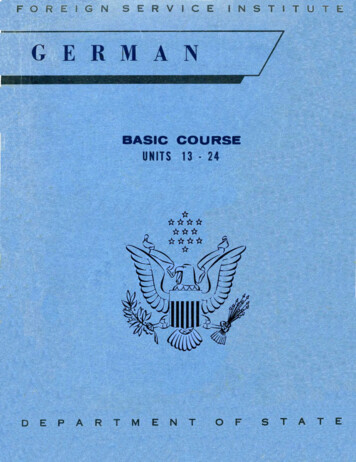
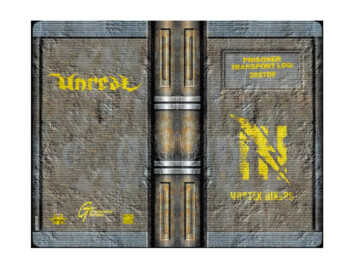
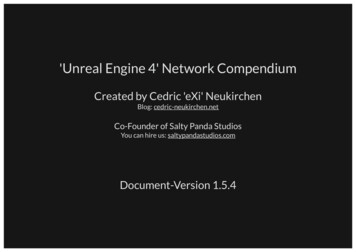
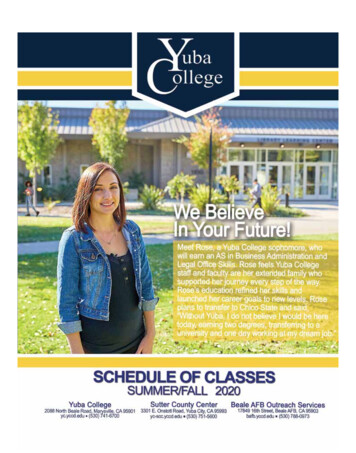

![Unreal Engine 4 Tutorial Blueprint Tutorial [1] Basic .](/img/5/ue4-blueprints-tutorial-2018.jpg)
